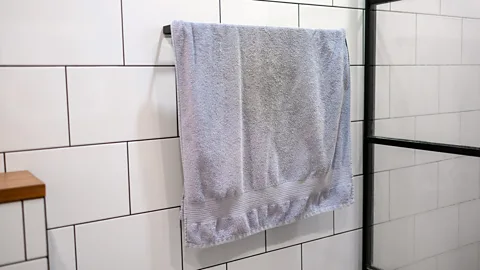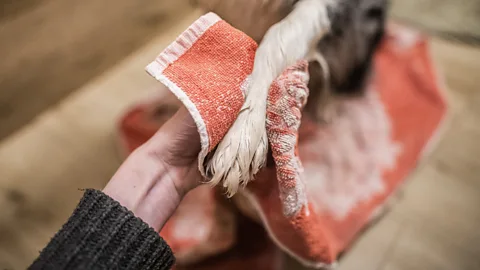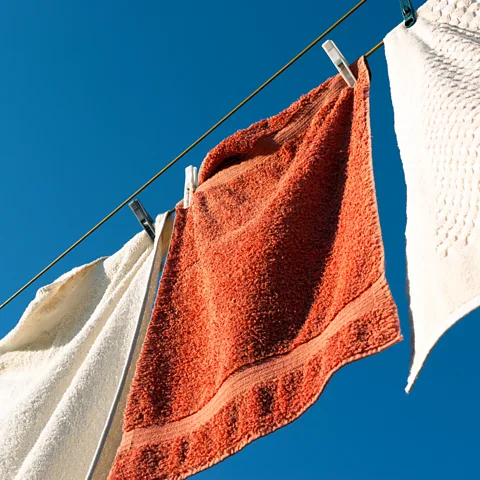Why you probably aren't washing your towels often enough
 Getty Images
Getty ImagesThe towels we dry ourselves with get a lot of use and pick up a lot of microbes along the way. But how long should you wait before throwing them into the laundry?
You have probably rubbed your body with one today already. But just how clean was that towel you dried yourself with? Many of us will pop them into the washing machine once a week, while one study of 100 people found about a third of them did so once a month. A few, according to one survey in the UK, admit to only doing it once a year.
And while those fluffy fibres might not show any signs of dirt, they are a breeding ground for millions of microbes. Studies have shown that towels can quickly become contaminated with bacteria commonly found on human skin, but also with those found in our guts.
Even after washing, our bodies are still covered in microbes and perhaps unsurprisingly when we dry ourselves off, some of these transfer onto our towel. But the microbes living on our towels come from other sources too – airborne fungi and bacteria can settle on towel fibres while they are hanging up. Some of the bacteria comes from the water we have used to launder the towels with in the first place.
In Japan, some households even reuse leftover bathwater for laundering the next day. One study by researchers at the University of Tokushima in Japan found, while this saves water, many of the bacteria found in the used bath water were then transferred to towels and clothing after being laundered.
And for those of us who prefer to leave our towels to dry in the same room as your lavatory, there is some rather disgusting news – every time you flush, you are likely giving any towels nearby a light dusting with bacteria from your toilet, along with specks of your family's bodily waste.
Over time these microbes can start to form biofilms on towels that can even begin changing how our towels look. After two months, even with regular washing, the bacteria living on cotton towel fibres start to dull the appearance of the cloth. But perhaps unsurprisingly, the total amount of bacteria and the species of bacteria depends on the laundry habits in the household. The real question is, how worried should you be about the bacteria living on your towels?
 Getty Images
Getty ImagesThe topic of towel washing might seem trivial, but Elizabeth Scott, a professor of biology and co-director of the Simmons University Center for Hygiene and Health in Home and Community in Boston, the US, is interested in what it can reveal about the way microbes spread around the home.
"They're not just naturally sitting around on towels," she says. "Anything that causes us harm on a towel is likely to have come from a human."
Indeed, there are as many as 1,000 different species of bacteria living on our skin alongside many other viruses and fungi. But most are actually good for us – helping to keep us safe from infections from other less friendly bacteria, breaking down some of the chemicals we encounter in daily life and playing an important role in the development of our immune systems.
Many of the bacteria that are found living on towels are the same species that we find on our skin, but are also common in the environments we live in. These include species of Staphylococcus bacteria and Escherichia coli, which is commonly found in the human gut, but also Salmonella and Shigella bacteria, which are common causes of foodborne illnesses and diarrhoea.
But some of these bacteria are also opportunistic pathogens – they are innocuous unless they get into a place where they can cause more harm, such as a cut, develop the ability to produce certain toxins or manage to infect people with weakened immune systems.
Our skin is also a natural barrier against infection. It is our first line of defence against bacteria and other pathogens, so transferring bacteria from a towel to our skin shouldn't worry us too much. But there is some evidence that washing, scrubbing and rubbing ourselves dry with a towel can also disrupt the skin's barrier function.
Perhaps the biggest problem occurs when we pick up potentially harmful microbes up on our hands as we dry them off before touching our mouth, nose and eyes. And that can mean the towels we use most frequently for our hands, perhaps deserve more attention. Kitchen towels, which are used on our dishes, hands and surfaces, are also another source of spread for foodborne pathogens.
Gastroenteric infections resulting from Salmonella, Norovirus and E. coli "are all transmissible through towels", according to Scott. Studies have also found that viruses such as Covid-19 can survive on cotton for up to 24 hours, although transmission through touching contaminated surfaces is not thought to be the main way the virus spreads.
Other viruses that do spread by contact, such as the mpox virus, may be more of a risk and health officials do not recommend sharing towels or linen with people who are infected.
Research has also shown that human papillomaviruses, which are a common cause of warts and verrucae can also be spread through contact with towels shared with other people.
The risk of transmitting infections from reusable hand towels is one reason why hospitals and public bathrooms now tend to use disposable paper towels and air dryers, although the evidence is inconclusive about which of those options is better.
 Getty Images
Getty ImagesClearly the longer we use towels, and the longer they stay damp for, the more hospitable the environment for microbes they become, increasing the chance of harmful microbes growing on them.
But thinking about towel hygiene could also help combat one of the major health issues facing the world, according to Scott and her colleagues. Antibiotic resistant bacteria, such as MRSA, can be transferred by contact with contaminated objects.
Jean-Yves Maillard, professor of pharmaceutical microbiology at Cardiff University, says practices like regular towel washing can help to reduce bacterial infections and in turn reduce the use of antibiotics. "Home hygiene is all to do with prevention, and prevention is better than treatment," says Maillard.
So, how often should we be washing our towels?
Scott suggests laundering towels once a week. However, this recommendation is not a set rule.
"It doesn't make a whole lot of sense because if someone is sick, they've got vomiting and diarrhoea," she says. "They need to have their own towel and those towels need to be laundered on a daily basis. That's what we call targeted hygiene, you deal with the risk as it occurs."
One study in India found that 20% of people who responded were washing their towels as often as twice a week.
Targeted hygiene is a risk management approach to hygiene, being developed by researchers associated with The Global Hygiene Council and The International Scientific Forum on Home Hygiene. Whilst hygiene is important to consider at all times, targeted hygiene focuses on the times and the places where these practices are vital.
According to Scott, towels require a hotter (40-60C, 104-140F) and longer wash than most household fabrics, often with the addition of antimicrobial detergents. Detergents can help to prevent bacteria from latching onto fabrics and inactivate some viruses. Of course, frequent washing at high temperatures comes with an environmental cost. (Find out more about how your daily water use affects the planet.)
For washes at lower temperatures, adding enzymes or bleach can help combat microbes on towels. One study in India also found combining a wash with a detergent with a disinfectant while rinsing and drying towels in the Sun was the most effective at reducing the bacterial and fungal load.
Scott refers to home hygiene as a form of altruism, much like vaccination. Each small practice you undertake to protect yourself, you also do to protect the people around you.
"We call it the Swiss cheese model," she says. "We think of all of these components as being slices of hygiene, like slices of Swiss cheese and every slice of hygiene covers up one of those holes and reduces the risk of pathogens being able to move through.
"Towels are a relatively small component, but there are definite risks with towels and it's easy to deal with that."
--
If you liked this story, sign up for The Essential List newsletter – a handpicked selection of features, videos and can't-miss news, delivered to your inbox twice a week.
